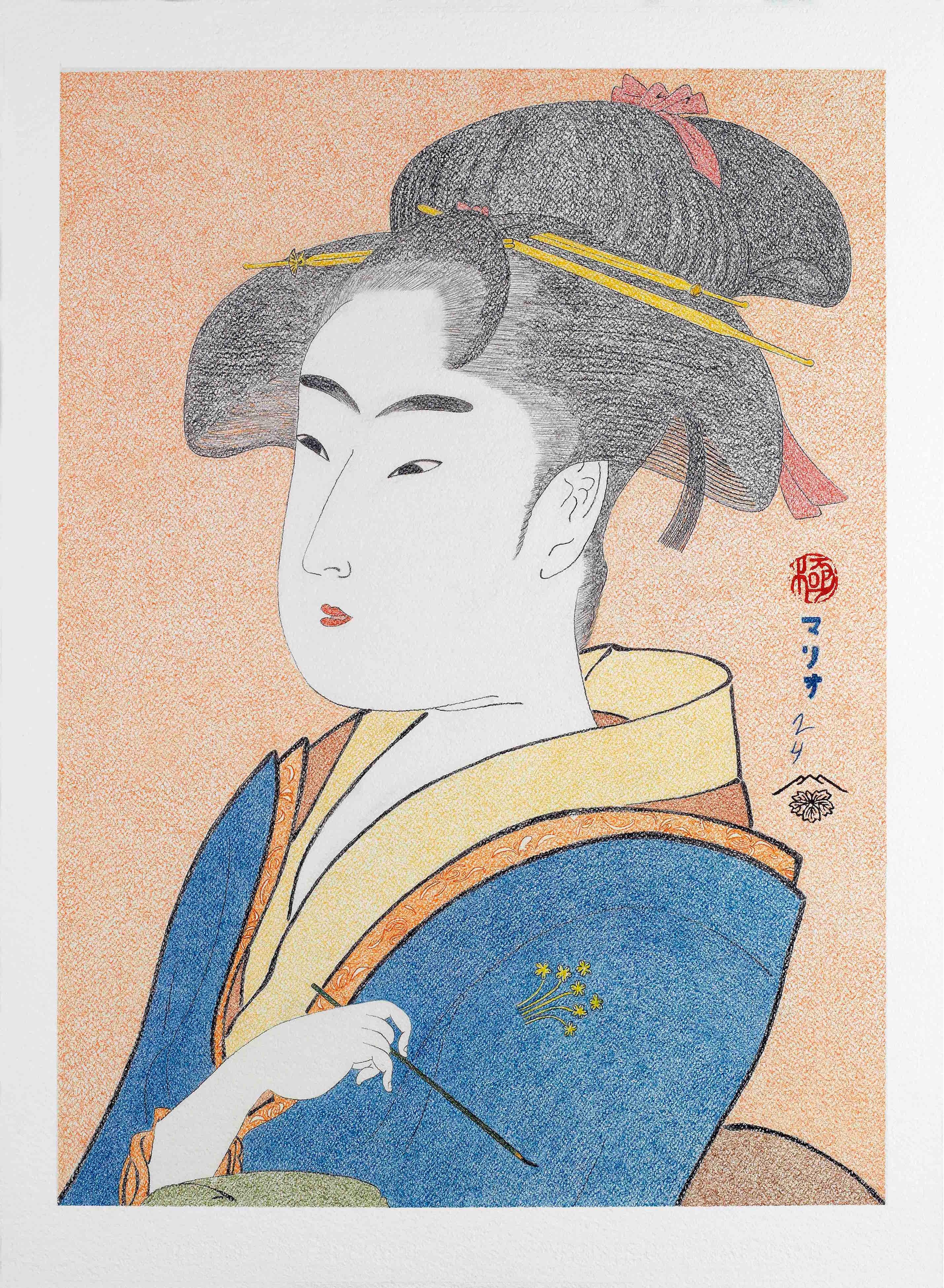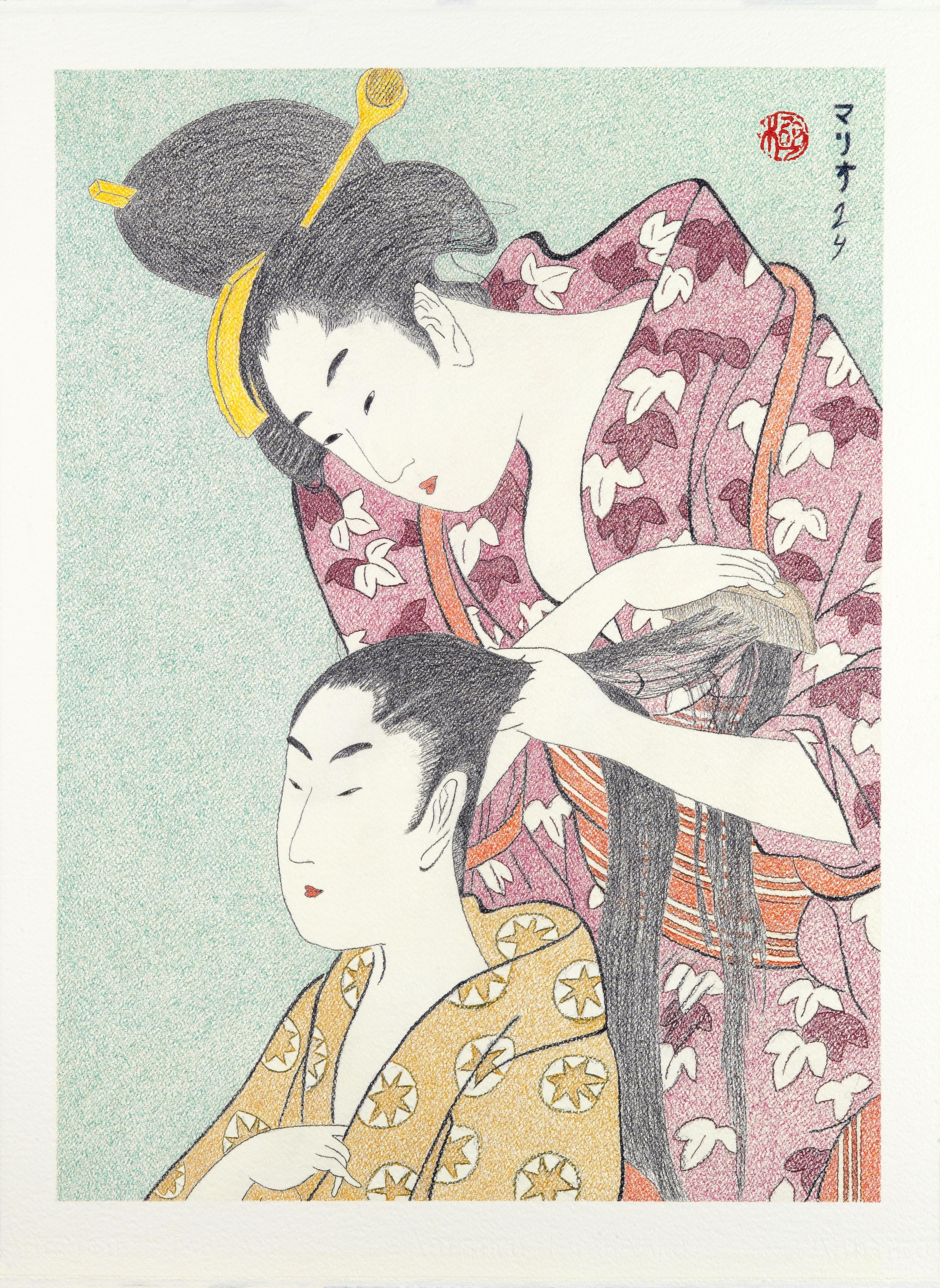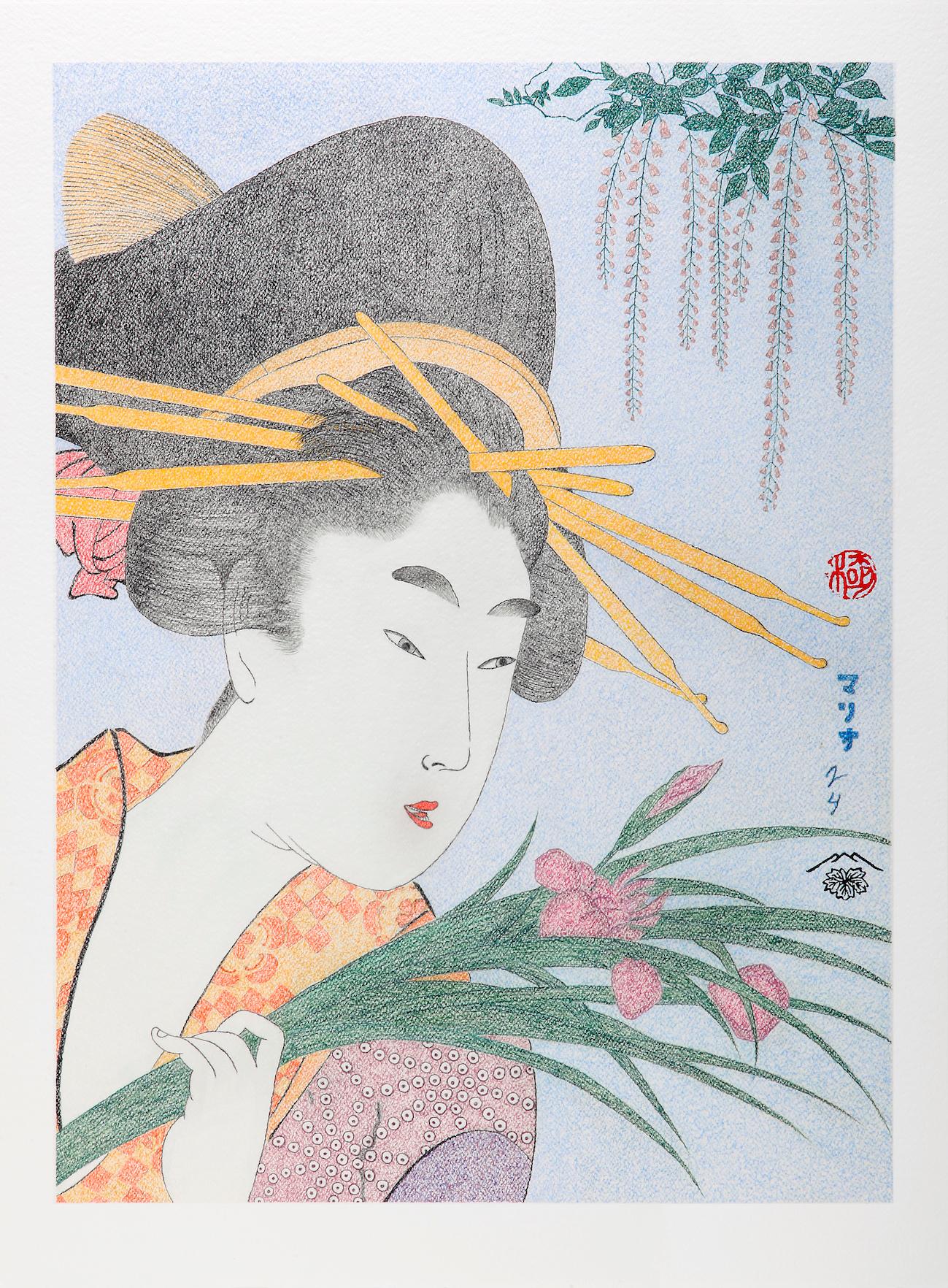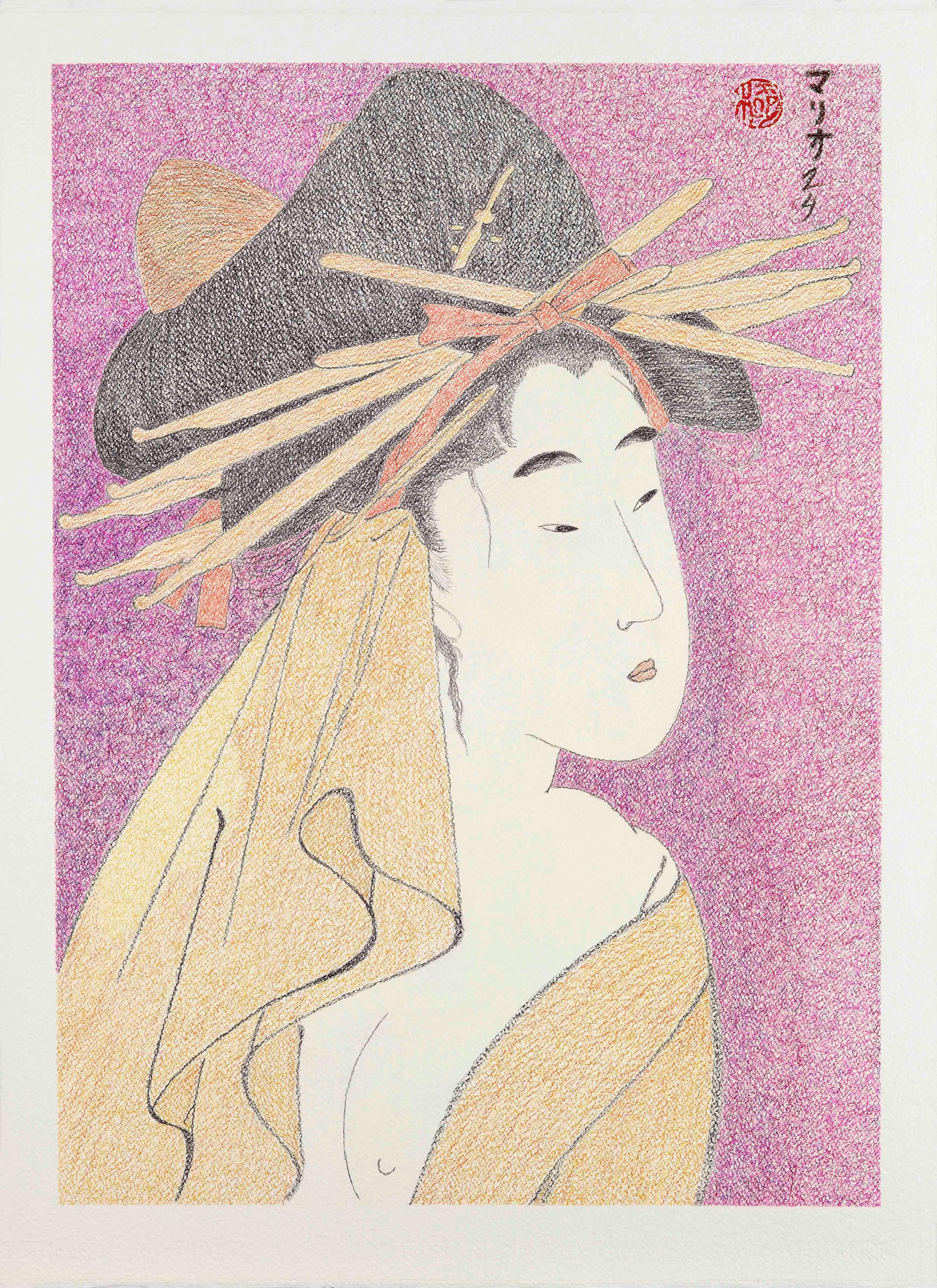Items Similar to Japanese Art Ukiyo-e Figurative Painting, Takashimayaoisha, Edo period
Want more images or videos?
Request additional images or videos from the seller
1 of 13
Mario B. GilJapanese Art Ukiyo-e Figurative Painting, Takashimayaoisha, Edo period2014
2014
About the Item
Beijing-ga Series XXX (nº 30)
Title: “Takashimaohisa”
Ohisa, along with Okita and Tomimoto Toyohina, were the three most famous beauties of the time. The first two were waitresses, and the third singer.
Ohisa, one of the preferred models by Utamaro, was the daughter of a craftsman specializing in the preparation of rice cakes. Since the early age of fourteen years old worked as a waitress in a tea house, next to the Ryogoku Bridge. By then she already had a numerous customer.
Utamaro represents her at a very early age, around sixteen. But already shows very confident in her beauty in a pose, without doubt, studied. The turn of her head to the left increases the length of the portrait.
The profile of her face, drawn with a line of a very fine stroke, contrast with the sophisticated hairstyle of dark tones, which at the same time brings out her long and white neck.
Ohisa holds a uchiwa or screen-shaped fan, in which sea stars are squared, and on a side a drawing of the three oak leaves that represents the family shield. It is that same shield that helped the specialists to identify Ohisa, since at that time it was forbidden to place the name of the celebrated beauties on the prints.
The geometric motives of the kimono contrast to the ornamental details of waves and birds of the obi.
This image is part of the bijin-ga series (“Pretty women”) drawn by Mario BGil, based in the Kitigawa Utamaro woodblock print Takashimaoisha (1790), 41,02 x 28,0 cm. Ohmi Gallery (or. Ross Walker)- Japan.
The artist reproduces the seal of the censor (Kiwame) and from the original publisher (Tsutaya, climbing leaf), between the two, the signature of Mario BGil written in Japanese, with the date 14 (2014).
The mesaurements of the drawing are 76 x 56 cm. (29,92 x 22,05 in.), with a painted surface of 67 x 49,5 cm. With frame 88 (H) x 67 (W) x 3.5 (D) cm. As this piece is framed, cannot be exported outside of Europe to prevent risks with framing.
With his work on the bijing-ga series, Mario BGil wanted to embellish, give brilliance and volume to the images presented by japanese artist Kitigawa Utamaro in those beautiful engravings, ennobled with the patina of time, which have served as inspiration. The result obtained is almost life-size portraits, endowed with strong chromaticism and valuable contrasts, all enhanced, in turn, with the volume provided by the weight and rigidity of the paper, and its thick texture (Fabriano Artistico “grana grosso”, 640g/m2.
In this way, Mario BGil pays tribute to his admired artist and offers us a new and enriched vision of this popular facet of oriental art from the 18th and 19th centuries.
ABOUT THE ARTIST
Mario BGil is a self-taught artist who for years has combined his creative activity with his work in the business world, away from commercial art galleries. Man of very diverse interests and great artistic sensitivity, studied Art History and in 2012, a deep interest in oriental art was awakened in him so that he began to study the great masters of Japanese Ukiyo-e prints, who had such an influence on the European avant-garde of the late 19th century.
The discovery of Kitagawa Utamaro (1753-1806), a key figure in the metropolitan culture of Edo (now Tokyo), and a point of reference in the history of Japanese engraving, meant for Mario a change of course caused by the imperative need to study his images, recreate them and recreate himself in them, incorporating certain changes in both the format and the technique used.
The technique used by MBG is very different from that used in engravings with wooden blocks impregnated in inks of intense colors that serve as a model. On a paper of heavy weight and thick texture, Mario BGil outlines with a black pencil, and colors the spaces with pencils and watercolors. Faced with the intensity of color of the prints (already very lost in some of them due to their age and exposure to the sun), their drawings are sifted by the streaky white, due to the thick texture of the paper, showing more lines, soft and warmer tones, giving color to the backgrounds but leaving all the volumes corresponding to the skin blank, thus giving the figures a classic serenity that transcends their oriental character.
Between 2014 and 2015, Mario BGil made more than 35 drawings based on the prints selected from the huge amount of work produced by the master Utamaro that shows images of courtesans in different attitudes and poses that highlight the subtle delicacy of oriental feminine beauty.
Kitagawa Utamaro was a faithful representative of the tastes of the Japanese bourgeoisie of its time, which had transformed the life of the cities giving birth to a culture parallel to the official and aristocratic.
The activity of the new rising group took place in special neighborhoods of Edo (Tokyo) and Osaka and its banality, inconsistency and frivolity earned it the name of Ukiyo: "floating world"; a world that will give priority to a series of cultural manifestations much more popular and less intellectualized than those preferred by the nobility. The new neighborhoods are filled with brothels and shows that the upper classes will consider vain, and a new breed of heroes: sumo wrestlers, singers, actors and courtesans will come to reign in this "floating world."
In front of the traditional painting the stamp arises with images of this new world. The courtesans of the pleasure districts of Edo that Utamaro portrays, do not always appear perfectly dressed to receive the client, but are surprised while getting ready, or during the day. He observes them without being seen, spy on them in their daily and intimate work. All of them are women drawn in a similar style, with elongated faces, straight delicate noses (almost a single line) and other features reduced to a mere suggestion (the mouth, a tiny butterfly of red).
The importance that it has had in later European artists (Degas, Toulouse-Lautrec, Bonnard, Gauguin, Van Gogh ...) has been great and Mario BGil has not been able to escape the recreation of those images so classic and, at the same time, so current, paying clear tribute to its original creator.
- Creator:Mario B. Gil (1962)
- Creation Year:2014
- Dimensions:Height: 34.65 in (88 cm)Width: 26.38 in (67 cm)Depth: 1.38 in (3.5 cm)
- Medium:
- Movement & Style:
- Period:
- Condition:As this piece is framed cannot be exported outside of Europe to prevent risks with framing.
- Gallery Location:Segovia, ES
- Reference Number:1stDibs: LU74437971462
About the Seller
5.0
Vetted Seller
These experienced sellers undergo a comprehensive evaluation by our team of in-house experts.
Established in 2002
1stDibs seller since 2017
58 sales on 1stDibs
- ShippingRetrieving quote...Ships From: Bilbao, Spain
- Return PolicyA return for this item may be initiated within 14 days of delivery.
More From This SellerView All
- Japanese Art Ikiyo-e Figurative Painting, Obvious Love Arawaruru Koi, Edo periodLocated in Segovia, ESBIJIN-GA SERIES XVIII (Nº 18) Title: Obvious Love (Arawaruru Koi) This image is part of the bijin-ga series (“Pretty women”) drawn by Mario BGil, based in the Kitigawa Utamaro woodblock print Obvious Love (Arawaruru Koi) (1793-94); 38,8 x 26,2 cm.. Art Institute Chicago, USA. A sensual woman seems to care little that her kimono is open, exposing a breast. Her hair is in disarray , the hairpin at the front about to fall and she holds one of the hairpins in her left hand. She appears to be looking down outside the frame of the picture, perhaps in mid-conversation. The term “arawaruru” refers to a love so wholehearted that it expresses itself in the lover´s face and mannerisms. In the 1780's and 90's the publisher Tsutaya Juzaburo and the designer Kitagawa Utamaro worked together on the production of many woodblock prints, most of them of the bijin-ga type. One of their most popular productions was a set of images that purported to depict psychological classifications of women - 'fickle', 'interesting', etc.. Perhaps in response to this success, they then came up with something similar - a set of prints...Category
2010s Edo Figurative Drawings and Watercolors
MaterialsPaper, Graphite, Crayon, Oil Crayon
- Japanese Art Ukiyo-e Figurative Painting, Tomimoto Toyohina, Edo periodLocated in Segovia, ESBijing-Ga series XXVII (Nº 27) Title: Tomomoto Toyohina Tomimoto Toyohina was a much sought-after geisha (entertainer) who performed narrative ballads accompanied by the shamisen. She was one of several non-prostitute beauties, including teahouse waitresses, whom Utamaro depicted repeatedly in the early to mid 1790s. She appears here with a brush in hand, dressed and combed with simple elegance. This composition is from a six-print series comprising half-length portraits of famous beauties (Famous beauties of Edo). Utamaro elevated Tomimoto Toyohina to the status of one of the three most renowned beauties of her age (together with Okita and Ohisa). She was from a prominent family of musicians that provided entertainment in the Yoshiwara. Toyohina’s appeal undoubtedly was as much due to her appearance as to her skills in singing, and Utamaro’s celebration of her would have further elevated the status of an already well-known lineage. This image is part of the bijin-ga series (“Pretty women”) drawn by Mario BGil, based in the Kitigawa Utamaro woodblock print...Category
2010s Edo Figurative Drawings and Watercolors
MaterialsCrayon, Paper, Oil Crayon, Graphite
- Japanese Art Ukiyo-e Figurative Painting, The courtese Hinakoto, Edo periodLocated in Segovia, ESBijin-ga series XXI (Nº 21) Title: The courtese Hinakoto of the Hyôgorô House of Edo The courtesan Hinakoto is depicted by smoking tobacco. She takes the pipe delicately in her left hand and, in her right hand, she seems to be holding a “uchiwa” (rigid hand fan) that comes out from the bottom of the drawing, decorated with written calligraphy. Some strands of hair that fall on her temple and her scant clothing show that the painter has surprised her in a relaxed moment in which she does not lose her elegance and slenderness. This image is part of the bijin-ga series (“Pretty women”) drawn by Mario BGil, based in the Kitigawa Utamaro woodblock print...Category
2010s Edo Figurative Drawings and Watercolors
MaterialsCrayon, Paper, Oil Crayon, Graphite
- Japanese Art Ukiyo-e Figurative Painting, Hairdresser, Edo periodLocated in Segovia, ESBijin-ga series II (nº 02) Title: “Hairdresser” The interest in this picture is focused on the hairstyles of both women, a hairdresser leaning forward with a bow of intense black color, arranging his client's especially long hair. The ways of gripping both the hair and the comb, making it slide through the ocher-scented kimono of the customer, decorated with sea stars, stand out. Highlighting with great detail the drawing of loose hair on the obi of white lines on a red background, and the kosode of plum color. This image is part of the Bijin-ga Series (“Pretty women”) drawn by Mario BGil, based in the Kitigawa Utamaro woodblock print "Hairdresser" (1798-1799), 39,8 x 26,8 cm. Museum of Fine Arts. Boston-USA. Utamaro drawn a series of twelve prints whose themes were related to the manual works of women, and this "Hairdresser" is one of them. Mario BGil reproduces the seal of the censor (Kiwame) and writes his own signature, Mario BGil, in Japanese, with the date 14 (2014). The mesaurements of the drawing are 76 x 56 cm. (29,92 x 22,05 in.), with a painted surface of 67 x 49,5 cm. With his work on the bijing-ga series, Mario BGil wanted to embellish, give brilliance and volume to the images presented by japanese artist Kitigawa Utamaro in those beautiful engravings, ennobled with the patina of time, which have served as inspiration. The result obtained is almost life-size portraits, endowed with strong chromaticism and valuable contrasts, all enhanced, in turn, with the volume provided by the weight and rigidity of the paper, and its thick texture (Fabriano Artistico “grana grosso”, 640g/m2; the thickness and hardness of the paper makes it necessary to transport it without rolling). In this way, Mario BGil pays tribute to his admired artist and offers us a new and enriched vision of this popular facet of oriental art from the 18th and 19th centuries. ABOUT THE ARTIST Mario BGil is a self-taught artist who for years has combined his creative activity with his work in the business world, away from commercial art galleries. Man of very diverse interests and great artistic sensitivity, studied Art History and in 2012, a deep interest in oriental art was awakened in him so that he began to study the great masters of Japanese Ukiyo-e prints, who had such an influence on the European avant-garde of the late 19th century. The discovery of Kitagawa Utamaro (1753-1806), a key figure in the metropolitan culture of Edo (now Tokyo), and a point of reference in the history of Japanese engraving...Category
2010s Edo Figurative Drawings and Watercolors
MaterialsCrayon, Paper, Oil Crayon, Graphite
- Japanese Art Ukiyo-e Figurative Painting, Hitomoto of the Daimonjiya, Edo periodLocated in Segovia, ES“Hitomoto of The Daimonjiya in Kyô-Machi Itchôme” Hitomoto holds a bouquet of flowers looking to her left, with a surprised face, and with her mouth aj...Category
2010s Edo Figurative Drawings and Watercolors
MaterialsCrayon, Paper, Oil Crayon, Graphite
- Japanese Art Ukiyo-e Figurative Painting, Karagoto of the Chojiya, Edo periodLocated in Segovia, ESBijin-ga Series I (Nº1) Title: Karagoto of The Chojiya Head and bust portrait of the beautiful courtesan Karagoto, of the Chojiya House, who appears looking to her left while drying her right ear with the sleeve of her yukata (a fine summer garment, normally made of cotton that was normally used after bathing). The wide sleeve falls from her ear covering her right breast and leaving the left one uncovered. This image is part of the bijin-ga series (“Pretty women”) drawn by Mario BGil, based in the Kitigawa Utamaro woodblock print...Category
2010s Edo Figurative Drawings and Watercolors
MaterialsCrayon, Paper, Oil Crayon, Graphite
You May Also Like
- "Truer Than True" ballpoint pen, figurative portraitBy Lauren RinaldiLocated in Philadelphia, PAOriginal drawing by Lauren Rinaldi float mounted in the pictured simple white frame measuring 17in x 14in. Lauren Rinaldi works using unbiased portraits of women’s bodies as a veh...Category
21st Century and Contemporary Contemporary Portrait Drawings and Waterco...
MaterialsBallpoint Pen, Archival Paper, Graphite, Oil Pastel
- "Veneer" Figurative Drawing, Color Pencil, Ballpoint Pen, GraphiteBy Lauren RinaldiLocated in Philadelphia, PA"Veneer" is an original oil pastel, ballpoint pen, color pencil, and graphite on arches paper work by Lauren Rinaldi. This piece ships in the pictured archival custom frame. The pape...Category
21st Century and Contemporary Contemporary Figurative Drawings and Water...
MaterialsArchival Paper, Oil Pastel, Ballpoint Pen, Color Pencil, Graphite
- "March Avery in Beret, " Milton Avery, American Modernism, Portrait of ArtistBy Milton AveryLocated in New York, NYMilton Clark Avery (1885 - 1965) March Avery in a Beret, 1951 Black crayon and graphite on cream wove paper 11 x 8 3/8 inches Signed and dated lower left; ...Category
1950s American Modern Portrait Drawings and Watercolors
MaterialsPaper, Crayon, Pencil, Graphite
- Polymorphisms IV - Haude Bernabé, 21st Century, Contemporary figurative drawingBy Haude BernabéLocated in Paris, FRInk and graphite on paper Signed, dated and entitled lower leftCategory
2010s Outsider Art Figurative Drawings and Watercolors
MaterialsPaper, Ink, Graphite
- Metamorphosis I - Haude Bernabé, 21st Century, Contemporary Figurative DrawingBy Haude BernabéLocated in Paris, FRInk and graphite on paper Signed, entitled and dated belowCategory
2010s Outsider Art Figurative Drawings and Watercolors
MaterialsPaper, Ink, Graphite
- Strangers - Haude Bernabé, 21st Century, Contemporary Figurative DrawingBy Haude BernabéLocated in Paris, FRInk and graphite on paper Signed, entitled and dated lower right by the artistCategory
2010s Outsider Art Figurative Drawings and Watercolors
MaterialsPaper, Ink, Graphite





